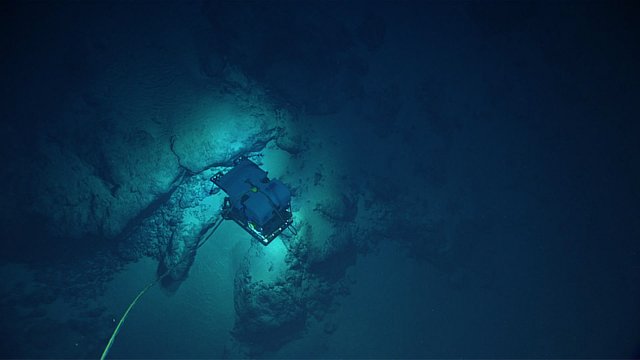The Changing Face of Our Oceans Part 14: Underwater Mining 2
Part 1, Part 2, Part 3, Part 4, Part 5, Part 6, Part 7, Part 8, Part 9, Part 10, Part 11, Part 12
Last time we discussed three of the types of undersea metal mining in use or development. Two of them, seafloor massive sulfides and polymetallic nodules, are among the most important resources available for development by humans. Sunken ships are considerably less important. Today we're going to discuss the other major type of seafloor mining, a less important but super cool type of potential future mining, and current mining efforts.

An ROV investingating cobalt rich ferromagnetic crusts off the coast of Samoa in a prospective mining zone. Image credit NOAA, licensed for public use. [Image source]
Cobalt-rich ferromanganese crusts are found on seamounts, undersea volcanoes found around the world. The crusts form on the rocks of the seamount by precipitation, somewhat similar to the way polymetallic nodules form. The process is extremely slow- the crusts grow at a rate of 1-5 mm per million years, and reach thicknesses of 260 mm. The water around seamounts, especially active ones, tends to be much, much richer in dissolved metals than the average region of the ocean- mostly because the volcano is actually pumping them out.
These crusts are in such high demand by mining companies for a few reasons, primarily composition related. While their composition is for the most part similar to polymetallic nodules (mostly iron and manganese), they have much more cobalt in them than the nodules, hence the name cobalt-rich ferromanganese crust. They also have non-negligible amounts of platinum and tellurium present in them.
A map of Davidson Seamount, off the coast of California. Undersea volcanoes like this are where cobalt-rich ferromanganese crusts are found. [Image source]
There are, however, quite a few problems with mining these crusts- which shouldn't be surprising, if you've been reading this series. First off is the practical objection- mining the crust will be extremely tricky. Currents tend to be extremely strong around seamounts, for one. Though we thought the crust primarily appeared in shallower water, Japanese scientists have discovered it as deep as five and a half kilometers. Mining the crust would also essentially take the form of strip mining, a daunting task underwater.
More important are the risks posed to seamount ecosystems. We've only explored a handful of the world's 33,000 seamounts, but literally every one we have explored has been a hotbed of ecological diversity. It really shouldn't be surprising that we see such ecological diversity at all three of the major deposits of undersea metals- the same reasons they're so rich in metals often contribute to the biological diversity of the area. While scientific studies are nowhere comprehensive of the seamounts, that's not to say they've been lacking- it's just that there are such an absurd number of seamounts out there to explore.
Seamount and Guyot distribution in the North Pacific. Guyots are flat-topped seamounts at least 3000 meters tall. Their flat tops come from once having been on the surface, and eroded flat by wave action. They tend to sink as they move along with the seafloor- the oceanic crust tends to settle and sink as it ages and cools. They're considerably less common than normal seamounts. [Image source]
I've brought up seamounts in this series before as the habitat of orange roughy, a fish almost wiped out by overfishing. Creatures on the seamounts tend to be slow-growing and reproducing, making it difficult for them to recover from population crashes. Seamounts often shelter delicate deep-water corals. Seamounts also serve as waystations for migrating fish- more fertile regions for them to feed and reproduce at.
Even focusing in more specifically on the cobalt rich ferromanganese crusts we see a huge diversity of life, much of which seems to actually prefer growing on the crust. Actually harvesting it would deal immense damage to the local ecosystems. Sediment clouds would be stirred up by mining, though they wouldn't be as bad as polymetallic nodule mining. All organisms living on the crust would be destroyed or displaced. Not to mention that it would produce immense amounts of sound pollution, light pollution, and just plain garbage.
A deepsea bubblegum coral atop Davidson Seamount with a grenadier fish swimming in front of it.. [Image source]
Thankfully, however, crust mining technology is much less advanced than the other mining techniques we've discussed so far. There's not even a Wikipedia page on the crust yet. Scientists are, thankfully, already pushing for further studies of seamount ecosystems and cobalt crusts, and the relatively higher difficulty and challenge of mining the crust has made it less of a priority of the other types of underwater mining. Scientists are, at the very least, calling for experimental test sites with multi-year observations afterwards before any serious mining is allowed.
I promised you all an undersea mining surprise- this one is, for once in this series, not depressing at all. It has to do with tunicates- sea squirts. Tunicate blood possesses some unusual properties. They have at least ten different types of blood cell, for more. More importantly, a few species of tunicate tend to accumulate large amounts of vanadium in their blood- in some cases, up to ten million times the amount found in seawater. This is extremely bizarre for a couple reasons. First of all, it has to be kept in a solution with a pH of less than 2 to be stable, so it's stored in vacuoules (little enclosed bubbles, essentially) filled with sulfuric acid.
The Bluebell tunicate. Tunicates are sessile filter feeders. [Image source]
Some scientists think the tunicate species that do this are doing it to deter predation- if you're a predator, you really don't want a mouthful of acid and heavy metals. Of course, other scientists think that it's to carry oxygen, so... Other species of tunicates are known to store lithium, iron, niobium, and tantalum in similar absurdly high concentrations. What does this have to do with mining, you ask? Well, if we can figure out how they concentrate things like this, it might allow us to do something similar- filtering out minerals from seawater seems, on the face of it, to be a much, much more environmentally friendly strategy that ripping them out of seamounts. There's discussion both of farming and breeding tunicates as well as using knowledge gained from them to make biotechnology to accomplish the same task.
Ultimately, what I and many other environmental advocates advise is a global moratorium on undersea mining until we better understand its dangers and effects. It also gives us a chance to have a genuine and in depth conversation on the way we actually use and dispose of resources. As a civilization, we need to get in the habit of reusing mineral resources again and again- a significant amount of the world's demand for metal is just lying in many of our junkyards. It's problematic, though- there's less profit to be made in rethinking the way we deal with resources, so there's not nearly as much effort put into it as in finding new resource deposits to profit off of.
More tunicates! Good photos of the vanadium storing tunicates are hard to find, so I just got some pretty photos for you all. [Image source]
Bibliography:
- https://en.wikipedia.org/wiki/Deep_sea_mining
- https://www.huffingtonpost.com/richard-steiner/deep-sea-mining-new-threa_b_8334428.html
- https://www.isa.org.jm/deep-sea-mineral-resources-cobalt-rich-ferromanganese
- https://worldoceanreview.com/en/wor-3/mineral-resources/cobalt-crusts/
- https://www.jamstec.go.jp/e/about/press_release/20160209/
- http://www.jogmec.go.jp/english/stockpiling/metal_10_000002.html
- https://www.globalresearch.ca/deep-sea-mining-environmental-impacts-on-the-sea-floor/5624042
- https://en.wikipedia.org/wiki/Seamount
- https://en.wikipedia.org/wiki/Davidson_Seamount
- https://en.wikipedia.org/wiki/Tunicate
- https://en.wikipedia.org/wiki/Vanabins

You received a 80.0% upvote since you are a member of geopolis and wrote in the category of "geology".
To read more about us and what we do, click here.
https://steemit.com/geopolis/@geopolis/geopolis-the-community-for-global-sciences-update-4
Very cool info about the tunicate's potential bio-mining application. It's probably just a pipedream at the moment, but I'd be amazed if it became an eco-friendly reality.
Me too, fingers crossed!
Undersea exploration is a very exciting field. And to think man has barely explored less than 1% of undersea treasures. So much prospects for the future.
There's a word of caution though. As man furrows more and more into undersea environments, the more he disturbs pristine Environments, and the higher the chances for pollution.
Thus, precautions must be taken to minimise such disruptions.
Thanks for this beautiful piece @mountainwashere.
Thanks for reading!
I fully endorse anything that teaches me new cool words.
Guyots.
Hah, thanks! Guyots are pretty fun, yeah.
Interesting and informative article. Thank you.
Your Post Has Been Featured on @Resteemable!
Feature any Steemit post using resteemit.com!
How It Works:
1. Take Any Steemit URL
2. Erase
https://3. Type
reGet Featured Instantly & Featured Posts are voted every 2.4hrs
Join the Curation Team Here | Vote Resteemable for Witness
Being A SteemStem Member
Congratulations! This post has been chosen as one of the daily Whistle Stops for The STEEM Engine!
You can see your post's place along the track here: The Daily Whistle Stops, Issue # 84 (3/25/18)
The STEEM Engine is an initiative dedicated to promoting meaningful engagement across Steemit. Find out more about us and join us today!